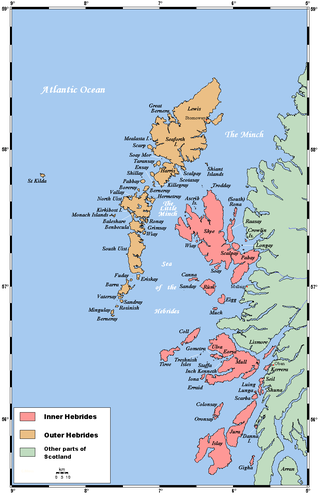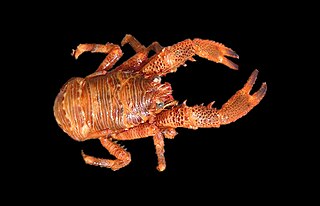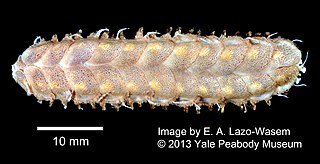
The Hebrides are an archipelago off the west coast of the Scottish mainland. The islands fall into two main groups, based on their proximity to the mainland: the Inner and Outer Hebrides.

The Pterophoridae or plume moths are a family of Lepidoptera with unusually modified wings, giving them the shape of a narrow winged airplane. Though they belong to the Apoditrysia like the larger moths and the butterflies, unlike these they are tiny and were formerly included among the assemblage called "microlepidoptera".

Aphrodita is a genus of marine polychaete worms found in the Mediterranean Sea and the Atlantic Ocean.

Jassa is a genus of amphipods in the family Ischyroceridae, comprising the following species:

Convolutidae is a family of acoels, belonging to the phylum Xenacoelomorpha. This family contains more than a third of all known acoel species.

Galathea is a genus of squat lobsters in the family Galatheidae. It is one of the largest genera of squat lobsters that in 2008 contained 73 species. Most species of Galathea live in shallow waters.

Metapenaeopsis, the velvet shrimps, is a prawn genus in the family Penaeidae. It contains these species:
Haswell Island is the largest of the Haswell Islands, lying off the coast of Antarctica, about 3 kilometres (1.5 nmi) north of Mabus Point in Queen Mary Land. It was discovered by the Western Base Party of the Australasian Antarctic Expedition, 1911–14, under Mawson, and named by him for Professor William A. Haswell, a zoologist at Sydney University and a member of the expedition's Advisory Committee.

Bellorchestia is a genus of amphipods of the family Talitridae, containing the following species:

Nototropis is a genus of amphipod crustaceans, in the family, Atylidae, and was first described by Achille Costa in 1853.

Sabellastarte is a genus of marine polychaete worms in the family Sabellidae.
Wulguru cuspidata is a microscopic acoel species that lives in the sandy beaches of northern Queensland (Australia). It is the second species of Australian free-living acoel to be described. Its generic name Wulguru is derived from Wulgurukaba, an Indigenous Australian people from Queensland, and the specific epithet is derived from cuspis, alluding to the characteristic single pointed tail of this animal.

Lepidonotus is a genus of marine annelids in the family Polynoidae. The genus occurs globally and includes 80 species, usually found in shallow waters down to about 80 metres.

Nymphopsis is a genus of sea spiders belonging to the family Ammotheidae.

Amaryllis is a genus of amphipods belonging to the family Amaryllididae. The genus was first described in 1879 by William Aitcheson Haswell, and the type species is Amaryllis macrophthalma Haswell, 1879.

Temnocephalidae is a family of flatworms belonging to the order Rhabdocoela, and was first described in 2021 by Van Steenkiste, Rivlin, Kahn, Wakeman & Leander.

Euphrosine is a genus of polychaetes belonging to the family Euphrosinidae.

Disporella is a genus of bryozoans belonging to the family Lichenoporidae.

Paraproto is a genus of marine amphipods in the family, Caprellidae, and was first described in 1903 by Paul Mayer. The type species is Paraproto condylata.

Aegiochus is a genus of isopods in the family Aegidae, first described in 1885 by Carl Bovallius. The type species is Aega ventrosa.

















